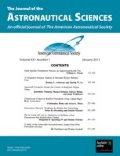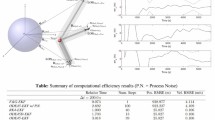Abstract
Shape and attitude of resident space objects directly affect the orbit propagation via drag and solar radiation pressure. Obtaining information beyond an object state is integral to identifying an object, aid in tracing its origin and its capabilities. For objects that have a significant distance to the observer, only non-resolved imaging is available, which does not reveal any details of the object. So-called non-resolved light curve measurements, i.e. brightness measurements over time, can be used to determine the shape of convex space objects using an inversion scheme. The inversion process starts by first determining the Extended Gaussian Image and then solving Minkowski problem to obtain the closed shape result. In this paper, the effect of measurement noise on the shape inversion and the influence of the measurement geometry is investigated. Despite the presence of measurement noise, in a new methodology, expanding upon established inversion techniques, almost perfect inversion results can be obtained in a two-step process: first, an initial light curve is used for shape hypothesis creation, and then, a second (potentially very short) light curve is used for selection of the best hypothesis. Results are shown for two standard shapes of a cuboid and a house shape.











Similar content being viewed by others
References
Armstrong, J.T., Hindsley, R.B., Restaino, S.R., Benson, J.A., Hutter, D.J., Vrba, F.J., Zavala, R.T., Gregory, S.A., Schmitt, H.R.: Observations of a geosynchronous satellite with optical interferometry. In: Adaptive Coded Aperture Imaging, Non-Imaging, and Unconventional Imaging Sensor Systems, Volume 7468 of Proceedings of the SPIE, p. 74680K (2009)
Cowardin, H., Abercromby, K., Barker, E., Seitzer, P., Mulrooney, M., Schildknecht, T.: An assessment of GEO orbital debris photometric properties derived from laboratory-based measurements. In: Advanced Maui Optical and Space Surveillance Technologies Conference, p. E25 (2009)
Cowardin, H., Lederer, S., Liou, J.-C., Ojakangas, G., Mulrooney, M.: Optical signature analysis of tumbling rocket bodies via laboratory measurements. In: Advanced Maui Optical and Space Surveillance Technologies Conference, p. 61 (2012)
Eapen, R.T., Frueh, C.: Averaged solar radiation pressure modeling for high area-to- mass ratio objects in geosynchronous orbits. Adv. Space. Res. 62(1), 127–141 (2018)
Friedman, A.M., Fan, S., Frueh, C.: Light curve inversion observability analysis. In: AIAA/AAS Astrodynamics Specialist Conference. AIAA Press (2019)
Friedman, A.M., Frueh, C.: Determining characteristics of artificial near-earth objects using observability analysis. Acta. Astronaut. 144, 405–421 (2018)
Früh, C., Kelecy, T., Jah, M.: Coupled orbit-attitude dynamics of high area-to-mass ratio (hamr) objects: Influence of solar radiation pressure, earth’s shadow and the visibility in light curves. Celest. Mech. Dyn. Astron. 117(4), 385–404 (2013)
Furfaro, R., Linares, R., Gaylor, D., Jah, M., Walls, R.: Resident space object characterization and behavior understanding via machine learning and ontology-based Bayesian networks. In: Advanced Maui Optical and Space Surveillance Technologies Conference, p. 35 (2016)
Gaylor, D., Anderson, J.: Use of hierarchical mixtures of experts to detect resident space object attitude. In: Advanced Maui Optical and Space Surveillance Technologies Conference, p. E70 (2014)
Hall, D., Hamada, K., Kelecy, T., Kervin, P.: Satellite surface characterization from non-resolved multi-band optical observations. In: Advanced Maui Optical and Space Surveillance Technologies Conference, p. 24 (2012)
Hejduk, M.: Specular and diffuse components in spherical satellite photometric modeling. In: Advanced Maui optical and space surveillance technologies conference, p. E15 (2011)
Horn, B: Sequins and Quills Representations for Surface Topography AI Memo 536. Massachusetts Institute of Technology, Artificial Intelligence Laboratory (1979)
Kaasalainen, M.: Asteroid models from photometry and complementary data sources. In: American Institute of Physics Conference Series, Volume 1732 of American Institute of Physics Conference Series, p. 020003 (2016)
Kaasalainen, M., Lamberg, L., Lumme, K., Bowell, E.: Interpretation of lightcurves of atmosphereless bodies. I - General theory and new inversion schemes. A&A 259, 318–332 (1992)
Kaasalainen, M., Torppa, J.: Optimization methods for asteroid lightcurve inversion. I shape determination. Icarus 153, 24–36 (2001)
Kaasalainen, M., Torppa, J., Muinonen, K.: Optimization methods for asteroid lightcurve inversion. II the complete inverse problem. Icarus 153, 37–51 (2001)
Kaasalainen, M., Torppa, J., Piironen, J.: Models of twenty asteroids from photometric data. Icarus 159, 369–395 (2002)
Linares, R., Crassidis, J.: Dynamic observability analysis for attitude, angular velocity, shape, and surface parameters. In: 26th AAS/AIAA Space Flight Mechanics Meeting, pp. 2016–515 (2016)
Linares, R., Crassidis, J.L.: Space-object shape inversion via adaptive hamiltonian Markov chain Monte Carlo. J. Guid. Control Dyn, 41(1), 47–58, 1 (2018)
Linares, R., Crassidis, J., Jah, M., Kim, H.: Astrometric and photometric data fusion for resident space object orbit, attitude, and shape determination via multiple-model adaptive estimation. In: AIAA Guidance, Navigation, and Control Conference, p. 8341 (2010)
Linares, R., Jah, M., Crassidis, J.: Inactive space object shape estimation via astrometric and photometric data fusion. Adv. Astronaut. Sci. 143, 217–232, 01 (2012)
Linares, R., Jah, M., Crassidis, J., Leve, F.A., Kelecy, T.: Astrometric and photometric data fusion for inactive space object mass and area estimation. Acta. Astronaut. 99, 1–15 (2014)
Little, J.J.: An iterative method for reconstructing convex polyhedra from extended gaussian images. In: Proceedings of the Third AAAI Conference on Artificial Intelligence, AAAI’83, pp. 247–250. AAAI Press (1983)
Little, J.J.: Extended gaussian images, mixed volumes, shape reconstruction. In: Proceedings of the First Annual Symposium on Computational Geometry, SCG ’85, pp 15–23. ACM, New York (1985)
Little, J.J.: Recovering Shape and Determining Attitude from Extended Gaussian Images. University of British Columbia, PhD thesis (1985)
Lynch, D., Russell, R., Rudy, R., Gutierrez, D., Turpin, M., Crawford, K., Dotan, Y., Kim, D., Skinner, M: 3 - 13 μ m spectra of geosynchronous satellites. In: The Advanced Maui Optical and Space Surveillance Technologies Conference, p. E81 (2006)
McMahon, J.W., Scheeres, D.J.: New solar radiation pressure force model for navigation. J. Guid. Control Dyn. 33(5), 1418–1428 (2010)
Minkowski, H.: Allgemeine Lehrsätze über die konvexen Polyeder, pp 121–139. Springer, Vienna (1989)
Minkowski, H.: Volumen und Oberfläche, pp 146–192. Springer, Vienna (1989)
Payne, T.E., Gregory, S.A., Dentamaro, A., Ernst, M., Hollon, J., Kruchten, A., Chaudhary, A.B., Dao, P.D.: Development and evaluation of new methods for estimating albedo-area for stable GEOs. In: Advanced Maui Optical and Space Surveillance (AMOS) Technologies Conference, p. 24 (2017)
Sanson, C., Frueh, F.: Noise quantification in optical observations of resident space objects for probability of detection and likelihood. In: AIAA/AAS Astrodynamics Specialist Conference. AIAA Press (2016)
Schildknecht, T., Koshkin, N., Korobeinikova, E., Melikiants, S., Shakun, L., Strakhova, S., Linder, E., Silha, J., Hager, M.: Photometric monitoring of non-resolved space debris and databases of optical light curves. In; Advanced Maui Optical and Space Surveillance Technologies Conference, p. 25 (2015)
Schildknecht, T., Musci, R., Fruh, C.P., Color, M.: Photometry and light curve observations of space debris in GEO. In: Advanced Maui Optical and Space Surveillance Technologies Conference, p. E51 (2008)
Schildknecht, T., Vannanti, A., Krag, H., Erd, C.: Reflectance spectra of space debris in GEO. In: Advanced Maui Optical and Space Surveillance Technologies Conference, p. E24 (2009)
Scott, R., Wallace, B.: Satellite characterization using small aperture instruments at DRDC Ottawa. In: Advanced Maui Optical and Space Surveillance Technologies Conference, p. E36 (2008)
Seitzer, P., Abercromby, K., Barker, E., Rodriguez, H.: Optical studies of space debris at GEO - survey and follow-up with two telescopes. In: Advanced Maui Optical and Space Surveillance Technologies Conference, p. E37 (2007)
White, R.A., Stemwedel, S.W.: The quadrilateralized spherical cube and quad-tree for all sky data. In: Worrall, D.M., Biemesderfer, C., Barnes, J. (eds.) Astronomical Data Analysis Software and Systems I, vol. 25, p 379. Astronomical Society of the Pacific Conference Series (1992)
Acknowledgements
This works was supported via AFOSR BAA Grant FA9550-18-1-0154 DEF.
Author information
Authors and Affiliations
Corresponding author
Additional information
Publisher’s Note
Springer Nature remains neutral with regard to jurisdictional claims in published maps and institutional affiliations.
Rights and permissions
About this article
Cite this article
Fan, S., Frueh, C. A Direct Light Curve Inversion Scheme in the Presence of Measurement Noise. J Astronaut Sci 67, 740–761 (2020). https://doi.org/10.1007/s40295-019-00190-3
Published:
Issue Date:
DOI: https://doi.org/10.1007/s40295-019-00190-3




